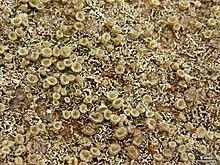Biography
Nash was born in Arlington, Virginia, in 1945. He received a B.Sc. from Duke University in 1967. It was around this time that he was introduced to lichens by ecologist Larry Bliss; he would later take an advanced undergraduate class on lichens given by William Culberson, and a lichenology summer course given by Mason Hale. Nash later went on to earn an M.Sc. (1969, botany) and Ph.D. (1971, botany and statistics) from Rutgers University, [1] under the supervision of ecologist Murray Fife Buell. [2] His Ph.D. thesis, titled Effect of Effluents from a Zinc Factory on Lichens, [1] was later published in the journal Ecological Monographs . [3]
Shortly after graduation, he accepted an assistant professorship from Arizona State University in Tempe, where he has spent much of his scientific career. He was promoted to associate professor of botany in 1976, and became a full professor with this institution in 1981. He taught courses in ecology, lichenology, statistics, and, on one occasion, bryology. Nash retired from Arizona State University in 2010. [1] For thirty years Nash and his students investigated Southern California's lichen communities and used them as biomonitors of air quality in the Los Angeles air basin. [4] After his retirement, Nash volunteered with the Wisconsin State Herbarium at the University of Wisconsin–Madison. [5]
Nash has developed a collection of over 110,000 lichen samples for the Arizona State University herbarium, for which he was the curator; [6] about 40,000 of these were collected by Nash himself during his nearly four decades at Arizona State University. [2] The collection features about 450 type specimens, and is represented by about 5,500 different species – about one-quarter of the known lichen species in the world. [1] It is among the ten largest collections of lichens in the United States. [2] His research is largely focused on the biology of lichens and the effects of air pollution on plants. He uses an interdisciplinary approach to research, and the topics of his research publications include ecophysiology, ecology, taxonomy, floristics, and biomonitoring. [7] He developed an interest in lichen physiology after working for a while with Otto Ludwig Lange at the University of Würzburg. Nash's interest in taxonomy developed with his work on the flora of the southwestern United States, and he is considered a leading expert in the family Parmeliaceae, particularly the genera Hypotrachyna and Xanthoparmelia . [1]

Major works by Nash include a revision of Xanthoparmelia species in South America, a monograph on Hypotrachyna for the journal Flora Neotropica, and a three-volume set on the lichen flora of the Greater Sonoran Desert. [1] [8] The latter project, funded by the National Science Foundation, was a large collaborative work involving more than 90 scientists from 23 countries. [6] [7] Taking almost 18 years to complete, much of the effort was taken up through numerous field trips to hundreds of localities throughout the region. As a result, this work, which covers almost 2,000 species – about 40% of the lichens known in North America – is considered an "authoritative taxonomic treatment" that "profoundly increased the understanding of the lichen biodiversity of the Sonoran Desert and surrounding environs". [1] These collecting expeditions resulted in the discovery of about 175 species new to science. [2]
In 2008, Nash was the chair of the organizing committee for the sixth International Lichenological Symposium, which was held at the Asilomar Conference Grounds in Monterey, California. [6] [9] As of 2011, Nash had mentored 30 graduate students (19 Ph.D. and 11 Masters), and authored or co-authored more than 200 peer-reviewed scientific publications. [1]
Personal
Thomas Nash is married to Corinna Gries, who is a professional in biodiversity informatics. She was a researcher in the Long Term Ecological Research Network in Arizona, and later at the University of Wisconsin. [1]









